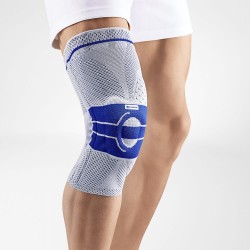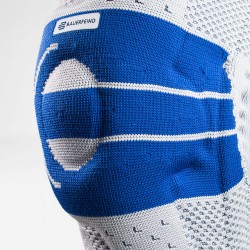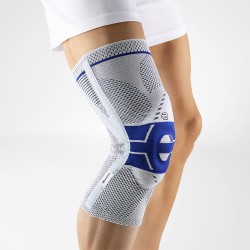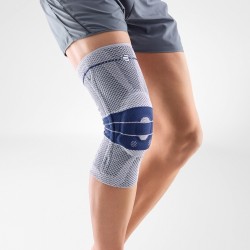
Knee pain: What causes it and how to prevent it
The amount of stress that the knee is able to withstand throughout your lifetime is a small miracle. Unfortunately, however, as the body ages, knee pain can become a common problem. Read our guide to find out how you can prevent damage and whether it is better to treat a serious injury using tape or a support.
The knee is the most complex joint in the body. This is understandable, because, as a hinge between the thigh and lower leg, it has to work hard constantly stretching and bending for many decades. For some people, this is combined with congenital weaknesses, and - depending on their level of sporting activity and occupation - powerful impacts or critical continuous loading.
Checklist for preventing knee pain
1. Exercise every day.
2. Participate in knee-friendly sports such as swimming, cycling, or Nordic walking, which are also excellent recreational sports.
3. Carry heavy loads in a way that is gentle on the knees - in a rucksack, for example.
4. Relieve your knee joint when possible by extending your leg and stretching your knee when sitting, for instance.
5. Avoid standing or kneeling for long periods of time.
6. Opt for cushioning footwear or soft ground.
7. Avoid bending the knee too much under loading.
8. Wear shoes with flat heels.
9. Keep an eye on your weight.
10. Train your leg muscles every day with targeted exercises.
Most people don't even think about the anatomy of the knee joint until knee pain first strikes. The knee joint is where the thigh and lower leg bones meet. In between these bones is the meniscus, formed of disks of cartilage, which fill the spaces in the joint. In front of these disks is the kneecap, which helps the upper thigh muscles to extend the lower leg. Collateral ligaments guide the knee joint and secure it when standing. The cruciate ligaments act as the safety rope when bending the knee, but they can be overloaded and tear during intense exercise.
Physically demanding occupations and some types of sports can really damage the knee
The tendons, ligaments, and the meniscus, which functions as a buffer zone in the knee joint, are particularly vulnerable areas in the event of impacts or unhealthy continuous loading. This situation is impossible to avoid in certain professions - tilers and gardeners are particularly vulnerable as they often have to work kneeling, as are those who have to carry heavy loads, such as furniture movers or delivery employees.
Some people also have congenital misalignments such as bandy legs or knock knees or an abnormally shaped patella. Obesity also poses a risk as the knees not only have to support a much greater load; it's also harder for those affected to remain healthy by taking part in sports. Sport is actually crucial because it is the only way to strengthen muscles and preserve the protective cartilage layer.
Sport, however, does also have its pitfalls: Cycling, Nordic walking at an average pace, and swimming are definitely healthy, but joggers and handball and basketball players are always at risk of developing strain injuries. It is also easy to tear or at the very least overstretch a tendon very suddenly when playing squash because of the abrupt changes in movement. Few people know that severely overstretched tendons and ligaments never completely regenerate.
Never squat too low
The popular squat exercise can also slowly lead to wear of the joint cartilage - at least if it is not performed correctly. You should never lower the thigh until it is horizontal; a 45- degree angle is sufficient.
Knee problems begin with clicking and twinges - these may be the first signs of tears in the cartilage and menisci. Left untreated, this can lead to osteoarthritis. According to a study, up to 8.5 million people in Germany are affected by this common condition.
Knee pain: What to do?
Checklist: Seek medical advice if you experience any of the following:
1. Knee pain that lasts longer than two days
2. Knee pain that occurs even when you are not putting weight on your knee
3. Limited movement in the knee or stability problems when walking or standing
If you answer any of these three checklist points with "yes," you should seek professional advice. Orthopedic surgeons and sports physicians are the best people to consult about problems of this kind.
There are two very similar solutions to relieve the pain: Taping up the knee or wearing a knee support. Both relieve the joint and reduce pain. Supports also provide neuromuscular stabilization. Tapes, which are also being used more and more frequently in professional sports, provide rapid relief for acute injuries, but they need to be replaced after a maximum of one week, and this is something that only an expert can do well. Supports, on the other hand, can be used for a long time, and unlike the case with tapes, you will be reimbursed by your health insurance company if the product has been prescribed by a physician.
What's more, if you are at an increased risk of developing osteoarthritis because of your occupation, sports, or a genetic predisposition, the use of a support is recommended as soon as you experience pain or a feeling of instability.









21 Comment(s)
What are the common causes of knee pain, and what steps can be taken to prevent it effectively?"\r\n\r\nRegards,\r\nPTS Terbaik
Tôi rất thích cách họ chăm sóc người chơi, mọi vấn đề đều được giải quyết nhanh chóng.\r\nTốc độ tải trang rất nhanh, tôi không bao giờ phải chờ đợi lâu.\r\nFB88 có một giao diện người dùng rất thân thiện, tôi có thể dễ dàng làm quen.
Khuyến mãi nạp tiền của FB88 khiến tôi cảm thấy rất có lợi.\r\nDịch vụ khách hàng của họ thật hoàn hảo, phản hồi nhanh chóng và thân thiện.\r\nFB88 cung cấp rất nhiều cách để nạp và rút tiền, đáp ứng nhu cầu của mọi người chơi.
Chức năng của nền tảng rất ổn định, gần như không có hiện tượng giật lag.\r\nFB88 luôn cung cấp các sản phẩm game chất lượng cao và dịch vụ khách hàng tốt.\r\nCác chương trình khuyến mãi của họ rất thú vị, luôn có điều gì đó bất ngờ chờ đợi tôi.
FB88 luôn cung cấp các sản phẩm game chất lượng cao và dịch vụ khách hàng tốt.\r\nCác game được cập nhật thường xuyên, tôi luôn có thể trải nghiệm nội dung mới nhất.\r\nTôi rất thích các trò chơi trên FB88, luôn có những sự kiện thú vị để tham gia.
LiveBet là một nền tảng giải trí trực tuyến sáng tạo, cung cấp cược thể thao trực tiếp và nhiều tính năng tương tác. Dù bạn là fan của bóng đá, bóng rổ hay các giải đấu eSports, LiveBet đều mang đến cho bạn trải nghiệm cược hấp dẫn. Với hệ thống cập nhật tỷ lệ cược nhanh chóng, bạn có thể cược trong suốt trận đấu và tận dụng mọi cơ hội chiến thắng. Các phương thức thanh toán an toàn và dịch vụ khách hàng 24/7 đảm bảo bạn chơi mà không lo lắng. Tham gia LiveBet ngay hôm nay để trải nghiệm cược trực tuyến tiên tiến nhất!
Trường Tiểu học Nguyễn Trung Trực được thành lập năm 1985 có địa chỉ tại 9A Phạm Hồng Thái, phường Nguyễn Trung Trực, quận Ba Đình, Hà Nội (Nay thành phường Trúc Bạch). Trường hoạt động dưới sự quản lý của UBND quận Ba Đình và Phòng Giáo dục và Đào tạo Ba Đình. Trường được xây dựng khang trang trên diện tích hơn 3000 m2 với đủ các phòng học và phòng chức năng cho các hoạt động học tập, vui chơi, giải trí của học sinh.\r\nĐịa chỉ: Số 9A Phạm Hồng Thái - Ba Đình - Hà Nội\r\nEmail: s666@s666s666s.com\r\nwebsite: Https://s666s666s.com/\r\nĐiện thoại: 438261441
Trường Tiểu học Nguyễn Trung Trực được thành lập năm 1985 có địa chỉ tại 9A Phạm Hồng Thái, phường Nguyễn Trung Trực, quận Ba Đình, Hà Nội (Nay thành phường Trúc Bạch). Trường hoạt động dưới sự quản lý của UBND quận Ba Đình và Phòng Giáo dục và Đào tạo Ba Đình. Trường được xây dựng khang trang trên diện tích hơn 3000 m2 với đủ các phòng học và phòng chức năng cho các hoạt động học tập, vui chơi, giải trí của học sinh.\r\nĐịa chỉ: Số 9A Phạm Hồng Thái - Ba Đình - Hà Nội\r\nEmail: s666@s666s666s.com\r\nwebsite: Https://s666s666s.com/\r\nĐiện thoại: 438261441
Trường Tiểu học Nguyễn Trung Trực được thành lập năm 1985 có địa chỉ tại 9A Phạm Hồng Thái, phường Nguyễn Trung Trực, quận Ba Đình, Hà Nội (Nay thành phường Trúc Bạch). Trường hoạt động dưới sự quản lý của UBND quận Ba Đình và Phòng Giáo dục và Đào tạo Ba Đình. Trường được xây dựng khang trang trên diện tích hơn 3000 m2 với đủ các phòng học và phòng chức năng cho các hoạt động học tập, vui chơi, giải trí của học sinh.\r\nĐịa chỉ: Số 9A Phạm Hồng Thái - Ba Đình - Hà Nội\r\nEmail: s666@s666s666s.com\r\nwebsite: Https://s666s666s.com/\r\nĐiện thoại: 438261441
Trường Tiểu học Nguyễn Trung Trực được thành lập năm 1985 có địa chỉ tại 9A Phạm Hồng Thái, phường Nguyễn Trung Trực, quận Ba Đình, Hà Nội (Nay thành phường Trúc Bạch). Trường hoạt động dưới sự quản lý của UBND quận Ba Đình và Phòng Giáo dục và Đào tạo Ba Đình. Trường được xây dựng khang trang trên diện tích hơn 3000 m2 với đủ các phòng học và phòng chức năng cho các hoạt động học tập, vui chơi, giải trí của học sinh.\r\nĐịa chỉ: Số 9A Phạm Hồng Thái - Ba Đình - Hà Nội\r\nEmail: s666@s666s666s.com\r\nwebsite: Https://s666s666s.com/\r\nĐiện thoại: 438261441
Trường Tiểu học Nguyễn Trung Trực được thành lập năm 1985 có địa chỉ tại 9A Phạm Hồng Thái, phường Nguyễn Trung Trực, quận Ba Đình, Hà Nội (Nay thành phường Trúc Bạch). Trường hoạt động dưới sự quản lý của UBND quận Ba Đình và Phòng Giáo dục và Đào tạo Ba Đình. Trường được xây dựng khang trang trên diện tích hơn 3000 m2 với đủ các phòng học và phòng chức năng cho các hoạt động học tập, vui chơi, giải trí của học sinh.\r\nĐịa chỉ: Số 9A Phạm Hồng Thái - Ba Đình - Hà Nội\r\nEmail: s666@s666s666s.com\r\nwebsite: Https://s666s666s.com/\r\nĐiện thoại: 438261441
Trường Tiểu học Nguyễn Trung Trực được thành lập năm 1985 có địa chỉ tại 9A Phạm Hồng Thái, phường Nguyễn Trung Trực, quận Ba Đình, Hà Nội (Nay thành phường Trúc Bạch). Trường hoạt động dưới sự quản lý của UBND quận Ba Đình và Phòng Giáo dục và Đào tạo Ba Đình. Trường được xây dựng khang trang trên diện tích hơn 3000 m2 với đủ các phòng học và phòng chức năng cho các hoạt động học tập, vui chơi, giải trí của học sinh.\r\nĐịa chỉ: Số 9A Phạm Hồng Thái - Ba Đình - Hà Nội\r\nEmail: s666@s666s666s.com\r\nwebsite: Https://s666s666s.com/\r\nĐiện thoại: 438261441
Trường Tiểu học Nguyễn Trung Trực được thành lập năm 1985 có địa chỉ tại 9A Phạm Hồng Thái, phường Nguyễn Trung Trực, quận Ba Đình, Hà Nội (Nay thành phường Trúc Bạch). Trường hoạt động dưới sự quản lý của UBND quận Ba Đình và Phòng Giáo dục và Đào tạo Ba Đình. Trường được xây dựng khang trang trên diện tích hơn 3000 m2 với đủ các phòng học và phòng chức năng cho các hoạt động học tập, vui chơi, giải trí của học sinh.\r\nĐịa chỉ: Số 9A Phạm Hồng Thái - Ba Đình - Hà Nội\r\nEmail: s666@s666s666s.com\r\nwebsite: Https://s666s666s.com/\r\nĐiện thoại: 438261441
Trường Tiểu học Nguyễn Trung Trực được thành lập năm 1985 có địa chỉ tại 9A Phạm Hồng Thái, phường Nguyễn Trung Trực, quận Ba Đình, Hà Nội (Nay thành phường Trúc Bạch). Trường hoạt động dưới sự quản lý của UBND quận Ba Đình và Phòng Giáo dục và Đào tạo Ba Đình. Trường được xây dựng khang trang trên diện tích hơn 3000 m2 với đủ các phòng học và phòng chức năng cho các hoạt động học tập, vui chơi, giải trí của học sinh.\r\nĐịa chỉ: Số 9A Phạm Hồng Thái - Ba Đình - Hà Nội\r\nEmail: s666@s666s666s.com\r\nwebsite: Https://s666s666s.com/\r\nĐiện thoại: 438261441
Insightful and so easy to understand. This is the kind of advice I needed.
One of the best posts I’ve read. Now I understand this so much better.
I visited many web sites however the audio quality for audio songs present at this web site is really excellent.
I conceive this site holds some very superb information for everyone :D.
I really like what you guys are up too. Such clever work and coverage! Keep up the awesome works guys I’ve included you guys to our blogroll.
Excellent post! We will be linking to this great post on our site. Keep up the great writing.
I will immediately seize your rss feed as I can not in finding your e-mail subscription link or e-newsletter service. Do you have any? Kindly let me recognise in order that I could subscribe. Thanks.
Leave a Comment